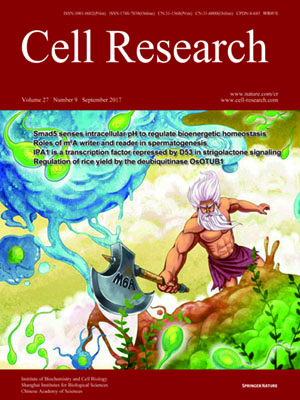
Volume 27, No 9, Sep 2017
ISSN: 1001-0602
EISSN: 1748-7838 2018
impact factor 17.848*
(Clarivate Analytics, 2019)
Volume 27 Issue 9, September 2017: 1157-1177
ORIGINAL ARTICLES
Fibroblasts in an endocardial fibroelastosis disease model mainly originate from mesenchymal derivatives of epicardium
Hui Zhang1,2,3,*, Xiuzhen Huang1,2,*, Kuo Liu1,2,3,*, Juan Tang1,2,*, Lingjuan He1,2, Wenjuan Pu1,2, Qiaozhen Liu1,2, Yan Li1,2, Xueying Tian1,2, Yue Wang1,2, Libo Zhang1,2, Ying Yu2,2, Hongyan Wang1, Ronggui Hu1, Fengchao Wang4, Ting Chen4, Qing-Dong Wang5, Zengyong Qiao6, Li Zhang7, Kathy O Lui8 and Bin Zhou1,2,3,9
1The State Key Laboratory of Cell Biology, CAS Center for Excellence in Molecular Cell Science, Shanghai Institute of Biochemistry and Cell Biology, Chinese Academy of Sciences, University of Chinese Academy of Sciences, Shanghai 200031, China;
2Key Laboratory of Nutrition and Metabolism, Institute for Nutritional Sciences, Shanghai Institutes for Biological Sciences, Graduate School of the Chinese Academy of Sciences, Chinese Academy of Sciences, Shanghai 200031, China;
3School of Life Science and Technology, ShanghaiTech University, Shanghai 201210, China;
4National Institute of Biological Sciences, Beijing 102206, China;
5Cardiovascular and Metabolic Diseases, Innovative Medicines and Early Clinical Development Biotech Unit, AstraZeneca, Mölndal 43183, Sweden;
6Department of Cardiovascular Medicine, Southern Medical University Affiliated Fengxian Hospital, Shanghai 201499, China;
7Department of Cardiology, the First Affiliated Hospital, School of Medicine, Zhejiang University, 79 Qingchun Road, Hangzhou, Zhejiang 310003, China;
8Department of Chemical Pathology, Li Ka Shing Institute of Health Sciences, The Chinese University of Hong Kong, Prince of Wales Hospital, Shatin, Hong Kong SAR 999077, China;
9Key Laboratory of Regenerative Medicine of Ministry of Education, Institute of Aging and Regenerative Medicine, Jinan University, Guangzhou, Guangdong 510632, China
Correspondence: Hui Zhang, E-mail: zhanghui1@shanghaitech.edu.cn; Bin Zhou,(zhoubin@sibs.ac.cn)
Endocardial fibroelastosis (EFE) refers to the thickening of the ventricular endocardium as a result of de novo deposition of subendocardial fibrous tissue layers during neonatal heart development. The origin of EFE fibroblasts is proposed to be postnatal endocardial cells that undergo an aberrant endothelial-to-mesenchymal transition (EndMT). Genetic lineage tracing of endocardial cells with the inducible endocardial Cre line Npr3-CreER and the endothelial cell tracing line Cdh5-CreER on an EFE-like model did not reveal any contribution of neonatal endocardial cells to fibroblasts in the EFE-like tissues. Instead, lineage tracing of embryonic epicardium by Wt1-CreER suggested that epicardium-derived mesenchymal cells (MCs) served as the major source of EFE fibroblasts. By labeling MCs using Sox9-CreER, we confirmed that MCs of the embryonic heart expand and contribute to the majority of neonatal EFE fibroblasts. During this pathological process, TGFβ signaling, the key mediator of fibroblasts activation, was highly upregulated in the EFE-like tissues. Targeting TGFβ signaling by administration of its antagonist bone morphogenetic protein 7 effectively reduced fibroblast accumulation and tissue fibrosis in the EFE-like model. Our study provides genetic evidence that excessive fibroblasts in the EFE-like tissues mainly originate from the epicardium-derived MCs through epicardial to mesenchymal transition (EpiMT). These EpiMT-derived fibroblasts within the EFE-like tissues could serve as a potential therapeutic target.
10.1038/cr.2017.10
FULL TEXT | PDF
Browse 1281


